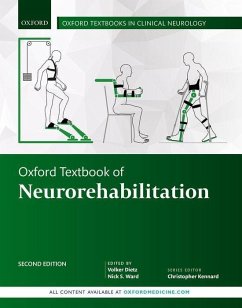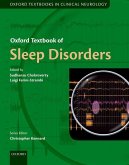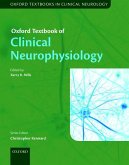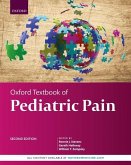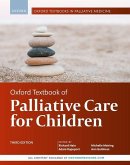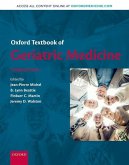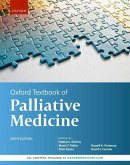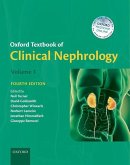Oxford Textbook of Neurorehabilitation
Herausgeber: Dietz, Volker; Ward, Nick S
Oxford Textbook of Neurorehabilitation
Herausgeber: Dietz, Volker; Ward, Nick S
- Gebundenes Buch
- Merkliste
- Auf die Merkliste
- Bewerten Bewerten
- Teilen
- Produkt teilen
- Produkterinnerung
- Produkterinnerung
Updated to reflect recent developments in the field, Oxford Textbook of Neurorehabilitation provides an understanding of the theoretical underpinnings of the subject along with a clear perspective on making treatment decisions on an individual basis. This is an indispensable book for those working with patients requiring neurorehabilitation.
Andere Kunden interessierten sich auch für
![Oxford Textbook of Sleep Disorders Oxford Textbook of Sleep Disorders]() Oxford Textbook of Sleep Disorders246,99 €
Oxford Textbook of Sleep Disorders246,99 €![Oxford Textbook of Clinical Neurophysiology Oxford Textbook of Clinical Neurophysiology]() Oxford Textbook of Clinical Neurophysiology279,99 €
Oxford Textbook of Clinical Neurophysiology279,99 €![Oxford Textbook of Pediatric Pain Oxford Textbook of Pediatric Pain]() Oxford Textbook of Pediatric Pain243,99 €
Oxford Textbook of Pediatric Pain243,99 €![Oxford Textbook of Palliative Care for Children Oxford Textbook of Palliative Care for Children]() Oxford Textbook of Palliative Care for Children208,99 €
Oxford Textbook of Palliative Care for Children208,99 €![Oxford Textbook of Geriatric Medicine Oxford Textbook of Geriatric Medicine]() Oxford Textbook of Geriatric Medicine553,99 €
Oxford Textbook of Geriatric Medicine553,99 €![Oxford Textbook of Palliative Medicine Oxford Textbook of Palliative Medicine]() Oxford Textbook of Palliative Medicine391,99 €
Oxford Textbook of Palliative Medicine391,99 €![Oxford Textbook of Clinical Nephrology Oxford Textbook of Clinical Nephrology]() Oxford Textbook of Clinical Nephrology1.138,99 €
Oxford Textbook of Clinical Nephrology1.138,99 €-
-
Updated to reflect recent developments in the field, Oxford Textbook of Neurorehabilitation provides an understanding of the theoretical underpinnings of the subject along with a clear perspective on making treatment decisions on an individual basis. This is an indispensable book for those working with patients requiring neurorehabilitation.
Hinweis: Dieser Artikel kann nur an eine deutsche Lieferadresse ausgeliefert werden.
Hinweis: Dieser Artikel kann nur an eine deutsche Lieferadresse ausgeliefert werden.
Produktdetails
- Produktdetails
- Verlag: Hurst & Co.
- 2nd edition
- Seitenzahl: 560
- Erscheinungstermin: 28. Juli 2020
- Englisch
- Abmessung: 282mm x 226mm x 33mm
- Gewicht: 1737g
- ISBN-13: 9780198824954
- ISBN-10: 0198824955
- Artikelnr.: 58304755
- Herstellerkennzeichnung
- Libri GmbH
- Europaallee 1
- 36244 Bad Hersfeld
- gpsr@libri.de
- Verlag: Hurst & Co.
- 2nd edition
- Seitenzahl: 560
- Erscheinungstermin: 28. Juli 2020
- Englisch
- Abmessung: 282mm x 226mm x 33mm
- Gewicht: 1737g
- ISBN-13: 9780198824954
- ISBN-10: 0198824955
- Artikelnr.: 58304755
- Herstellerkennzeichnung
- Libri GmbH
- Europaallee 1
- 36244 Bad Hersfeld
- gpsr@libri.de
Professor Dr Volker Dietz completed his medical training and specialisation in neurology and neurophysiology at the University of Freiburg, Germany. His research is predominantly focused on human neuronal control and movement disorders. Between 1977 and 1992, Professor Dietz was an Assistant Professor in the Department of Neurology and Neurophysiology at the University of Freiburg, after which he was appointed as Head of the Spinal Cord Injury Center at the University Hospital Balgrist and Chair of Paraplegiology at the University of Zurich. He is a Fellow of the Royal College of Physicians (FRCP) and a Consultant for the MRC Council, the German Research Council, the Danish National Research Foundation, the Swiss National Science Foundation, and the European Commission. A recipient of the German Research Council's Preis der Hoffnung Award in 1998, Professor Dietz has published over 280 peer-reviewed papers. Professor Dr Nick S. Ward is Reader in Clinical Neurology and an Honorary Consultant Neurologist at The National Hospital for Neurology and Neurosurgery. He trained in medicine at Charing Cross & Westminster Hospital, going on to obtain his postgraduate neurology training at The National Hospital for Neurology and Neurosurgery. He was awarded the first Clinical Fellowship in Stroke Medicine by the Stroke Association in 1999, after which he worked as a Wellcome Trust funded clinical research fellow at the Wellcome Trust Centre for Neuroimaging. In 2011, he was promoted to Reader in Clinical Neurology, and in 2017 to Professor of Clinical Neurology and Neurorehabilitation in the Sobell Department of Motor Neuroscience at UCL. A co-founder of the UCLP Centre for Neurorehabilitation and Associate Editor of the journals Neurorehabilitation and Neuronal Repair and Journal of Neurology, Neurosurgery and Psychiatry , Professor Ward's special clinical interest is stroke and neurorehabilitation.
* SECTION I: General aspects of neurorehabilitation
* 1: Diane Playford: The International Classification of Functioning,
Disability, and Health
* 2: Derick Wade: A teamwork approach to neurological rehabilitation
* 3: Rory J. O Connor: The economic benefits of rehabilitation for
neurological conditions
* 4: Gert Kwakkel and Boudewijn Kollen: Predicting activities after
stroke
* 5: Bruce Dobkin and Clarisa Martinez: Designing a clinical trial for
neurorehabilitation
* 6: Markus Wirz and Louise Rutz-LaPitz: The influence of age on
neurorehabilitation
* 7: John W. Krakauer: The applicability of motor learning to
neurorehabilitation
* SECTION II: Physiological consequences of CNS damage
* 8: Michèle Hubli and Volker Dietz: Spinal neuronal dysfunction after
deprivation of supraspinal input
* 9: Volker Dietz and Thomas Sinkjær: Secondary changes after damage of
the central nervous system: Significance of spastic muscle tone in
rehabilitation
* 10: Tom E. Nightingale, Ulrich Mehnert, Thomas M. Kessler, and Andrei
Krassioukov: Autonomous nervous system dysfunction
* 11: Steffen Franz, Andreas Hug, and Norbert Weidner: Functional
recovery in CNS disease: Impact of animal models
* SECTION III: Neuroplasticity and repair
* 12: Andreas R. Luft: Animal models of damage, repair, and plasticity
in the brain
* 13: Patrick Freund, V. Reggie Edgerton, Roland R. Roy, Daniel C. Lu,
and Yury Gerasimenko: Animal models of damage, repair and plasticity
in the spinal cord
* 14: Sebastian Jessberger, Armin Curt, and Roger A. Barker: Stem cell
application in neurorehabilitation
* 15: Nick S. Ward: The role of neuroimaging in understanding the
impact of neuroplasticity after CNS damage
* 16: Orlando B. C. Swayne and John C. Rothwell: Enhancement of
neuroplasticity by cortical stimulation
* 17: Ulf Ziemann: Enhancement of neuroplasticity by drug therapy
* SECTION IV: Clinical concepts
* 18: Jacques Duysens, Geert Verheyden, Firas Massaad, Pieter Meyns,
Bouwien Smits-Engelsman, and Ilse Jonkers: Rehabilitation of gait and
balance after CNS damage
* 19: William Huynh, Michael Lee, and Matthew C. Kiernan:
Neurorehabilitation approaches for disorders of the peripheral
nervous system
* 20: Nick S. Ward: Treatment of arm and hand dysfunction after CNS
damage
* 21: Alex Leff and Jenny Crinion: Acquired disorders of language and
their treatment
* 22: Radek Ptak and Armin Schnider: Neuropsychological rehabilitation
of higher cortical functions after brain damage
* 23: Tom Hughes and Tom Richards: The clinical neurology of problems
with oral feeding
* 24: Ulrich Mehnert and Thomas Kessler: Management of bladder, bowel,
and sexual dysfunction
* 25: Eva Widerström-Noga: The assessment and treatment of pain
syndromes in neurorehabilitation
* 26: Killian A. Welch and Mansur A. Kutlubaev: The impact of fatigue
on neurorehabilitation
* 27: Andy Tyerman: Vocational Rehabilitation
* 28: Fiona Jones and Sara Demain: Self-management strategies in
neurorehabilitation
* 29: Gail Eva, Jo Bayly, and Diane Playford: Neuropalliative
rehabilitation: Managing neurological disability in the context of
deteriorating illness
* 30: Lucia Ricciardi, Alan J. Carson, and Mark J. Edwards: Recognition
and management of functional symptoms after traumatic brain injury
* SECTION V: Technical concepts
* 31: Eckart Altenmüller and Lauren Stewart: Music supported therapy in
neurorehabilitation
* 32: Jacopo Carpaneto and Silvestro Micera: Application of orthoses
and neurostimulation in neurorehabilitation
* 33: Arthur Prochazka: Technology to enhance arm and hand function
* 34: Rüdiger Rupp, Daniel Schließmann, Christian Schuld, and Norbert
Weidner: Technology to enhance locomotor function
* 35: Émilie Raymond, Luc Noreau, Normand Boucher, Geoffrey Edwards,
Patrick Fougeyrollas, Ernesto Morales, Francois Routhier, Claude
Vincent, and G. Hubert Gascon: Enhancing independent community access
and participation: Services, technologies, and policies
* 36: Mathias Bannwart and Robert Riener: Virtual reality for
neurorehabilitation
* 37: Arun Jayaraman, Sheila Burt, and William Z. Rymer: Promises and
challenges of neurorehabilitation technology
* 1: Diane Playford: The International Classification of Functioning,
Disability, and Health
* 2: Derick Wade: A teamwork approach to neurological rehabilitation
* 3: Rory J. O Connor: The economic benefits of rehabilitation for
neurological conditions
* 4: Gert Kwakkel and Boudewijn Kollen: Predicting activities after
stroke
* 5: Bruce Dobkin and Clarisa Martinez: Designing a clinical trial for
neurorehabilitation
* 6: Markus Wirz and Louise Rutz-LaPitz: The influence of age on
neurorehabilitation
* 7: John W. Krakauer: The applicability of motor learning to
neurorehabilitation
* SECTION II: Physiological consequences of CNS damage
* 8: Michèle Hubli and Volker Dietz: Spinal neuronal dysfunction after
deprivation of supraspinal input
* 9: Volker Dietz and Thomas Sinkjær: Secondary changes after damage of
the central nervous system: Significance of spastic muscle tone in
rehabilitation
* 10: Tom E. Nightingale, Ulrich Mehnert, Thomas M. Kessler, and Andrei
Krassioukov: Autonomous nervous system dysfunction
* 11: Steffen Franz, Andreas Hug, and Norbert Weidner: Functional
recovery in CNS disease: Impact of animal models
* SECTION III: Neuroplasticity and repair
* 12: Andreas R. Luft: Animal models of damage, repair, and plasticity
in the brain
* 13: Patrick Freund, V. Reggie Edgerton, Roland R. Roy, Daniel C. Lu,
and Yury Gerasimenko: Animal models of damage, repair and plasticity
in the spinal cord
* 14: Sebastian Jessberger, Armin Curt, and Roger A. Barker: Stem cell
application in neurorehabilitation
* 15: Nick S. Ward: The role of neuroimaging in understanding the
impact of neuroplasticity after CNS damage
* 16: Orlando B. C. Swayne and John C. Rothwell: Enhancement of
neuroplasticity by cortical stimulation
* 17: Ulf Ziemann: Enhancement of neuroplasticity by drug therapy
* SECTION IV: Clinical concepts
* 18: Jacques Duysens, Geert Verheyden, Firas Massaad, Pieter Meyns,
Bouwien Smits-Engelsman, and Ilse Jonkers: Rehabilitation of gait and
balance after CNS damage
* 19: William Huynh, Michael Lee, and Matthew C. Kiernan:
Neurorehabilitation approaches for disorders of the peripheral
nervous system
* 20: Nick S. Ward: Treatment of arm and hand dysfunction after CNS
damage
* 21: Alex Leff and Jenny Crinion: Acquired disorders of language and
their treatment
* 22: Radek Ptak and Armin Schnider: Neuropsychological rehabilitation
of higher cortical functions after brain damage
* 23: Tom Hughes and Tom Richards: The clinical neurology of problems
with oral feeding
* 24: Ulrich Mehnert and Thomas Kessler: Management of bladder, bowel,
and sexual dysfunction
* 25: Eva Widerström-Noga: The assessment and treatment of pain
syndromes in neurorehabilitation
* 26: Killian A. Welch and Mansur A. Kutlubaev: The impact of fatigue
on neurorehabilitation
* 27: Andy Tyerman: Vocational Rehabilitation
* 28: Fiona Jones and Sara Demain: Self-management strategies in
neurorehabilitation
* 29: Gail Eva, Jo Bayly, and Diane Playford: Neuropalliative
rehabilitation: Managing neurological disability in the context of
deteriorating illness
* 30: Lucia Ricciardi, Alan J. Carson, and Mark J. Edwards: Recognition
and management of functional symptoms after traumatic brain injury
* SECTION V: Technical concepts
* 31: Eckart Altenmüller and Lauren Stewart: Music supported therapy in
neurorehabilitation
* 32: Jacopo Carpaneto and Silvestro Micera: Application of orthoses
and neurostimulation in neurorehabilitation
* 33: Arthur Prochazka: Technology to enhance arm and hand function
* 34: Rüdiger Rupp, Daniel Schließmann, Christian Schuld, and Norbert
Weidner: Technology to enhance locomotor function
* 35: Émilie Raymond, Luc Noreau, Normand Boucher, Geoffrey Edwards,
Patrick Fougeyrollas, Ernesto Morales, Francois Routhier, Claude
Vincent, and G. Hubert Gascon: Enhancing independent community access
and participation: Services, technologies, and policies
* 36: Mathias Bannwart and Robert Riener: Virtual reality for
neurorehabilitation
* 37: Arun Jayaraman, Sheila Burt, and William Z. Rymer: Promises and
challenges of neurorehabilitation technology
* SECTION I: General aspects of neurorehabilitation
* 1: Diane Playford: The International Classification of Functioning,
Disability, and Health
* 2: Derick Wade: A teamwork approach to neurological rehabilitation
* 3: Rory J. O Connor: The economic benefits of rehabilitation for
neurological conditions
* 4: Gert Kwakkel and Boudewijn Kollen: Predicting activities after
stroke
* 5: Bruce Dobkin and Clarisa Martinez: Designing a clinical trial for
neurorehabilitation
* 6: Markus Wirz and Louise Rutz-LaPitz: The influence of age on
neurorehabilitation
* 7: John W. Krakauer: The applicability of motor learning to
neurorehabilitation
* SECTION II: Physiological consequences of CNS damage
* 8: Michèle Hubli and Volker Dietz: Spinal neuronal dysfunction after
deprivation of supraspinal input
* 9: Volker Dietz and Thomas Sinkjær: Secondary changes after damage of
the central nervous system: Significance of spastic muscle tone in
rehabilitation
* 10: Tom E. Nightingale, Ulrich Mehnert, Thomas M. Kessler, and Andrei
Krassioukov: Autonomous nervous system dysfunction
* 11: Steffen Franz, Andreas Hug, and Norbert Weidner: Functional
recovery in CNS disease: Impact of animal models
* SECTION III: Neuroplasticity and repair
* 12: Andreas R. Luft: Animal models of damage, repair, and plasticity
in the brain
* 13: Patrick Freund, V. Reggie Edgerton, Roland R. Roy, Daniel C. Lu,
and Yury Gerasimenko: Animal models of damage, repair and plasticity
in the spinal cord
* 14: Sebastian Jessberger, Armin Curt, and Roger A. Barker: Stem cell
application in neurorehabilitation
* 15: Nick S. Ward: The role of neuroimaging in understanding the
impact of neuroplasticity after CNS damage
* 16: Orlando B. C. Swayne and John C. Rothwell: Enhancement of
neuroplasticity by cortical stimulation
* 17: Ulf Ziemann: Enhancement of neuroplasticity by drug therapy
* SECTION IV: Clinical concepts
* 18: Jacques Duysens, Geert Verheyden, Firas Massaad, Pieter Meyns,
Bouwien Smits-Engelsman, and Ilse Jonkers: Rehabilitation of gait and
balance after CNS damage
* 19: William Huynh, Michael Lee, and Matthew C. Kiernan:
Neurorehabilitation approaches for disorders of the peripheral
nervous system
* 20: Nick S. Ward: Treatment of arm and hand dysfunction after CNS
damage
* 21: Alex Leff and Jenny Crinion: Acquired disorders of language and
their treatment
* 22: Radek Ptak and Armin Schnider: Neuropsychological rehabilitation
of higher cortical functions after brain damage
* 23: Tom Hughes and Tom Richards: The clinical neurology of problems
with oral feeding
* 24: Ulrich Mehnert and Thomas Kessler: Management of bladder, bowel,
and sexual dysfunction
* 25: Eva Widerström-Noga: The assessment and treatment of pain
syndromes in neurorehabilitation
* 26: Killian A. Welch and Mansur A. Kutlubaev: The impact of fatigue
on neurorehabilitation
* 27: Andy Tyerman: Vocational Rehabilitation
* 28: Fiona Jones and Sara Demain: Self-management strategies in
neurorehabilitation
* 29: Gail Eva, Jo Bayly, and Diane Playford: Neuropalliative
rehabilitation: Managing neurological disability in the context of
deteriorating illness
* 30: Lucia Ricciardi, Alan J. Carson, and Mark J. Edwards: Recognition
and management of functional symptoms after traumatic brain injury
* SECTION V: Technical concepts
* 31: Eckart Altenmüller and Lauren Stewart: Music supported therapy in
neurorehabilitation
* 32: Jacopo Carpaneto and Silvestro Micera: Application of orthoses
and neurostimulation in neurorehabilitation
* 33: Arthur Prochazka: Technology to enhance arm and hand function
* 34: Rüdiger Rupp, Daniel Schließmann, Christian Schuld, and Norbert
Weidner: Technology to enhance locomotor function
* 35: Émilie Raymond, Luc Noreau, Normand Boucher, Geoffrey Edwards,
Patrick Fougeyrollas, Ernesto Morales, Francois Routhier, Claude
Vincent, and G. Hubert Gascon: Enhancing independent community access
and participation: Services, technologies, and policies
* 36: Mathias Bannwart and Robert Riener: Virtual reality for
neurorehabilitation
* 37: Arun Jayaraman, Sheila Burt, and William Z. Rymer: Promises and
challenges of neurorehabilitation technology
* 1: Diane Playford: The International Classification of Functioning,
Disability, and Health
* 2: Derick Wade: A teamwork approach to neurological rehabilitation
* 3: Rory J. O Connor: The economic benefits of rehabilitation for
neurological conditions
* 4: Gert Kwakkel and Boudewijn Kollen: Predicting activities after
stroke
* 5: Bruce Dobkin and Clarisa Martinez: Designing a clinical trial for
neurorehabilitation
* 6: Markus Wirz and Louise Rutz-LaPitz: The influence of age on
neurorehabilitation
* 7: John W. Krakauer: The applicability of motor learning to
neurorehabilitation
* SECTION II: Physiological consequences of CNS damage
* 8: Michèle Hubli and Volker Dietz: Spinal neuronal dysfunction after
deprivation of supraspinal input
* 9: Volker Dietz and Thomas Sinkjær: Secondary changes after damage of
the central nervous system: Significance of spastic muscle tone in
rehabilitation
* 10: Tom E. Nightingale, Ulrich Mehnert, Thomas M. Kessler, and Andrei
Krassioukov: Autonomous nervous system dysfunction
* 11: Steffen Franz, Andreas Hug, and Norbert Weidner: Functional
recovery in CNS disease: Impact of animal models
* SECTION III: Neuroplasticity and repair
* 12: Andreas R. Luft: Animal models of damage, repair, and plasticity
in the brain
* 13: Patrick Freund, V. Reggie Edgerton, Roland R. Roy, Daniel C. Lu,
and Yury Gerasimenko: Animal models of damage, repair and plasticity
in the spinal cord
* 14: Sebastian Jessberger, Armin Curt, and Roger A. Barker: Stem cell
application in neurorehabilitation
* 15: Nick S. Ward: The role of neuroimaging in understanding the
impact of neuroplasticity after CNS damage
* 16: Orlando B. C. Swayne and John C. Rothwell: Enhancement of
neuroplasticity by cortical stimulation
* 17: Ulf Ziemann: Enhancement of neuroplasticity by drug therapy
* SECTION IV: Clinical concepts
* 18: Jacques Duysens, Geert Verheyden, Firas Massaad, Pieter Meyns,
Bouwien Smits-Engelsman, and Ilse Jonkers: Rehabilitation of gait and
balance after CNS damage
* 19: William Huynh, Michael Lee, and Matthew C. Kiernan:
Neurorehabilitation approaches for disorders of the peripheral
nervous system
* 20: Nick S. Ward: Treatment of arm and hand dysfunction after CNS
damage
* 21: Alex Leff and Jenny Crinion: Acquired disorders of language and
their treatment
* 22: Radek Ptak and Armin Schnider: Neuropsychological rehabilitation
of higher cortical functions after brain damage
* 23: Tom Hughes and Tom Richards: The clinical neurology of problems
with oral feeding
* 24: Ulrich Mehnert and Thomas Kessler: Management of bladder, bowel,
and sexual dysfunction
* 25: Eva Widerström-Noga: The assessment and treatment of pain
syndromes in neurorehabilitation
* 26: Killian A. Welch and Mansur A. Kutlubaev: The impact of fatigue
on neurorehabilitation
* 27: Andy Tyerman: Vocational Rehabilitation
* 28: Fiona Jones and Sara Demain: Self-management strategies in
neurorehabilitation
* 29: Gail Eva, Jo Bayly, and Diane Playford: Neuropalliative
rehabilitation: Managing neurological disability in the context of
deteriorating illness
* 30: Lucia Ricciardi, Alan J. Carson, and Mark J. Edwards: Recognition
and management of functional symptoms after traumatic brain injury
* SECTION V: Technical concepts
* 31: Eckart Altenmüller and Lauren Stewart: Music supported therapy in
neurorehabilitation
* 32: Jacopo Carpaneto and Silvestro Micera: Application of orthoses
and neurostimulation in neurorehabilitation
* 33: Arthur Prochazka: Technology to enhance arm and hand function
* 34: Rüdiger Rupp, Daniel Schließmann, Christian Schuld, and Norbert
Weidner: Technology to enhance locomotor function
* 35: Émilie Raymond, Luc Noreau, Normand Boucher, Geoffrey Edwards,
Patrick Fougeyrollas, Ernesto Morales, Francois Routhier, Claude
Vincent, and G. Hubert Gascon: Enhancing independent community access
and participation: Services, technologies, and policies
* 36: Mathias Bannwart and Robert Riener: Virtual reality for
neurorehabilitation
* 37: Arun Jayaraman, Sheila Burt, and William Z. Rymer: Promises and
challenges of neurorehabilitation technology

